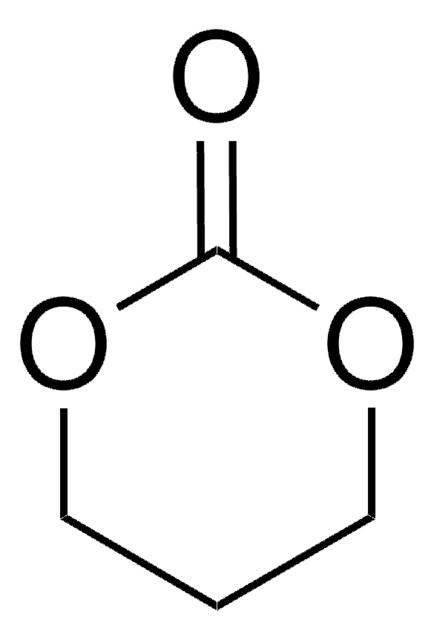Products may be shipped at a different temperature than the recommended long-term storage temperature. If the product quality is sensitive to short-term exposure to conditions other than the recommended long-term storage, it will be shipped on wet or dry-ice. If the product quality is NOT affected by short-term exposure to conditions other than the recommended long-term storage, it will be shipped at ambient temperature. As shipping routes are configured for minimum transit times, shipping at ambient temperature helps control shipping costs for our customers. For more information, please refer to the Storage and Transport Conditions document: https://www.sigmaaldrich.com/deepweb/assets/sigmaaldrich/marketing/global/documents/316/622/storage-transport-conditions-mk.pdf
455067
4-(Hydroxymethyl)-1,3-dioxolan-2-one
Sinonimo/i:
(2-Oxo-1,3-dioxolan-4-yl)methanol, 3-Hydroxypropene carbonate, 3-Hydroxypropylene carbonate, 4-Methylolethylene carbonate, Glycerin carbonate, Glycerol 1,2-carbonate
Scegli un formato
About This Item
Prodotti consigliati
Indice di rifrazione
n20/D 1.469 (lit.)
Livello qualitativo
P. ebollizione
137-140 °C/0.5 mmHg (lit.)
Densità
1.4 g/mL at 25 °C (lit.)
Gruppo funzionale
carbonate
hydroxyl
Stringa SMILE
OCC1COC(=O)O1
InChI
1S/C4H6O4/c5-1-3-2-7-4(6)8-3/h3,5H,1-2H2
JFMGYULNQJPJCY-UHFFFAOYSA-N
Categorie correlate
Applicazioni
- 4-[(prop-2-en-1-yloxy)methyl]-1,3-dioxolan-2-one (AGC) via Williamson ether synthesis with 3-bromoprop-1-ene.[1]
- Hyperbranched polyethers via copolymerization with cyclic carbonate containing phthalimide moieties.[2]
- (2-Oxo-1,3-dioxolan-4-yl)methyl benzeneacetate by reacting with phenylacetyl chloride.[3]
Codice della classe di stoccaggio
10 - Combustible liquids
Classe di pericolosità dell'acqua (WGK)
WGK 1
Punto d’infiammabilità (°F)
230.0 °F - closed cup
Punto d’infiammabilità (°C)
110 °C - closed cup
Dispositivi di protezione individuale
Eyeshields, Gloves, multi-purpose combination respirator cartridge (US)
Scegli una delle versioni più recenti:
Possiedi già questo prodotto?
I documenti relativi ai prodotti acquistati recentemente sono disponibili nell’Archivio dei documenti.
I clienti hanno visto anche
-
How is shipping temperature determined? And how is it related to the product storage temperature?
1 answer-
Helpful?
-
-
How can I determine the shelf life / expiration / retest date of this product?
1 answer-
If this product has an expiration or retest date, it will be shown on the Certificate of Analysis (COA, CofA). If there is no retest or expiration date listed on the product's COA, we do not have suitable stability data to determine a shelf life. For these products, the only date on the COA will be the release date; a retest, expiration, or use-by-date will not be displayed.
For all products, we recommend handling per defined conditions as printed in our product literature and website product descriptions. We recommend that products should be routinely inspected by customers to ensure they perform as expected.
For products without retest or expiration dates, our standard warranty of 1 year from the date of shipment is applicable.
For more information, please refer to the Product Dating Information document: https://www.sigmaaldrich.com/deepweb/assets/sigmaaldrich/marketing/global/documents/449/386/product-dating-information-mk.pdfHelpful?
-
Active Filters
Il team dei nostri ricercatori vanta grande esperienza in tutte le aree della ricerca quali Life Science, scienza dei materiali, sintesi chimica, cromatografia, discipline analitiche, ecc..
Contatta l'Assistenza Tecnica.







